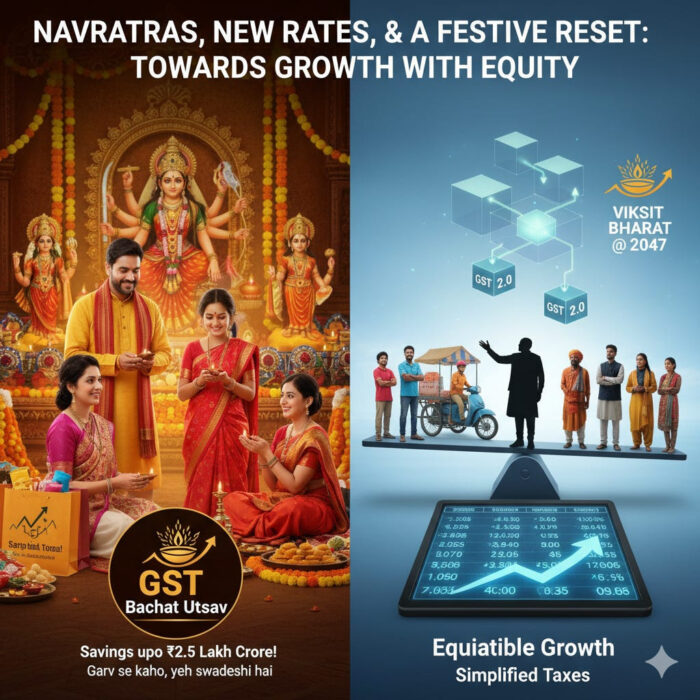 On the eve of the auspicious Navratras—nine days before the festival of Dussehra—Prime Minister Narendra Modi’s 5 p.m. address set an upbeat tone for the season. With GST 2.0 taking effect tomorrow, households and small businesses alike have cause to welcome what he framed as a simpler, kinder tax interface. Reduced rates on daily essentials, a streamlined slab structure to cut compliance friction, and a clear reaffirmation of “one nation, one tax” together signal a policy attempt to put more money in people’s pockets while un-knotting the old indirect-tax maze.
On the eve of the auspicious Navratras—nine days before the festival of Dussehra—Prime Minister Narendra Modi’s 5 p.m. address set an upbeat tone for the season. With GST 2.0 taking effect tomorrow, households and small businesses alike have cause to welcome what he framed as a simpler, kinder tax interface. Reduced rates on daily essentials, a streamlined slab structure to cut compliance friction, and a clear reaffirmation of “one nation, one tax” together signal a policy attempt to put more money in people’s pockets while un-knotting the old indirect-tax maze.
The address, delivered amid the confusion and imbroglio created by President Trump’s sudden rejig of the H1B visa regime—an upheaval that affects Indian nationals in the largest percentage terms globally—sought to steady nerves at home with a festive promise. The Prime Minister’s announcement of a “GST Bachat Utsav” from 22 September captures the mood: savings of up to ₹2.5 lakh crore this year, if realised, would be tangible for families planning festive purchases. His Swadeshi call—“Garv se kaho, yeh swadeshi hai”—fits naturally with the celebratory arc of the next few months, inviting citizens and storefronts to go Vocal for Local. The formation of a Task Force for Next-Generation Reforms underlines intent beyond festivities: a modern, efficient, citizen-friendly economy as a stepping stone to Viksit Bharat, which no longer appears to be a distant milestone. In spirit and symbolism, it is a resonant message for a country about to light lamps, exchange gifts, and count blessings.
Beyond Celebration: Fixing India’s Skewed Distribution of Income and Wealth
The speech deserves applause. Yet, if we are honest about our Republic’s obligations under the Directive Principles of State Policy—notably Article 38 (to minimise inequalities) and Article 39(b)–(c) (to prevent concentration of wealth)—we must confront a stubborn reality: India’s distribution of income and wealth is acutely unequal. A thin sliver at the very top captures a disproportionately large share of both, while the lower-middle and poor carry heavier relative burdens.

The indirect-tax tilt—and why GST feels regressive at the bottom
Indirect taxes, by design, bite regardless of ability to pay. While GST 2.0 trims rates on essentials (welcome and overdue), the structure still means poorer households spend a larger fraction of their income on taxed consumption than the rich. That regressivity intensifies when high-income households can shift big-ticket spending into corporate entities—buying or leasing luxury assets through companies—thereby stacking advantages that ordinary salaried or self-employed citizens do not enjoy:
Depreciation benefits on high-value assets purchased via the company,
Interest deductions where acquisitions are debt-financed, and
Input tax credits (ITC) on a range of business inputs and services (even as ITC on motor cars is generally restricted except for specified uses, corporates still net meaningful credits elsewhere in the consumption chain).
By contrast, the neighbourhood retailer, the gig professional, or the lower-middle-class family buying the same categories of goods out of post-tax income sees no such offsets. The net effect: the system can look neutral in statute yet feel unequal in practice.
A personal–corporate rate paradox that rankles
Add to this the rate geometry on direct taxes. For many individuals in the top personal slab, surcharges and cesses push the effective rate above what domestic companies, especially startups, face. Even as corporate tax reform aimed to boost investment, the optics—and outcomes—now appear skewed against the hardworking individual or self-employed taxpayer. Start-up wealth dynamics have widened the chasm further: founders and early investors may ultimately pay at capital-gains rates on outsized outcomes, while professionals in equivalent income bands pay full freight on salaries or professional receipts with limited deductions.
The new code from April 2026—unfinished business
The new Income-tax code slated for practical implementation from 1 April 2026 promises simplification but, as of now, does not decisively correct these structural imbalances. Without a distribution-aware redesign, simplification risks becoming cosmetic: easier to comply with, yes—but not fairer in incidence.
A Mid-Course Correction: Seven Practical Steps
Re-balance the tax mix toward progressivity.
Preserve lower GST rates on essentials and consider a deeper zero-rating basket for nutrition, health, and core utilities. Finance this by firming up higher GST slabs for clear luxury items and non-merit services, coupled with tighter anti-avoidance on misclassification.
Ring-fence corporate channels for personal luxury.
Sharpen rules (and enforcement) on corporate purchase of high-end consumer assets used substantially for personal consumption. Where business use is incidental, cap or disallow deductions and proportionate ITC; require use-logs and fringe benefit valuation with pre-set safe harbours to reduce disputes.
Level the personal–corporate rate playing field.
Either reduce top-end personal surcharges or introduce a High-Income Minimum Tax (HIMT) that ensures ultra-high earners—regardless of the form of income—face a floor effective rate comparable to (or higher than) corporates.
Rationalise capital-gains across asset classes.
Fewer holding-period buckets, closer rate convergence, and anti-arbitrage rules between salary/professional income and closely held equity cash-outs. Keep true start-up risk-taking attractive, but temper windfalls with progressive surcharges above substantial thresholds.
Modernise wealth-adjacent taxation without chilling enterprise.
Consider calibrated instruments—better property valuation and annual property taxes, stronger inheritance disclosure (even if a full estate duty is off the table), and targeted second-home/ultra-luxury levies—earmarked to urban services and affordable housing.
Protect small firms and self-employed cashflows.
Accelerate GST refunds via time-bound, interest-bearing processing; expand presumptive regimes with digital-audit trails; and offer a standard deduction for the self-employed that mirrors salaried reliefs.
Measure what matters—and publish it.
Commit to distributional national accounts: regular, public statistics showing how growth, taxes, and subsidies affect each decile. What gets measured, gets managed—and trusted.
The Constitutional North Star and the 2047 Test
Our Constitution’s Directive Principles are not decorative—they are directional. If we aspire to a multi-trillion-dollar economy and Viksit Bharat by 2047, we must pivot from headline fixes to incidence fairness: who pays, who benefits, and whether mobility ladders are sturdy for the poor and lower-middle class. The good news is that progressive reform need not be anti-growth. In fact, a fairer incidence map can improve demand resilience, widen the base of entrepreneurship, and deepen social consent for reform.
Prime Minister Modi has the clout, vision, determination, and dynamism to deliver that mid-course correction. Having launched GST 2.0 on a festive note and rekindled the Swadeshi spirit, he is uniquely placed—over the next four years of the present Lok Sabha and beyond—to align our tax architecture with constitutional equity. Let the Navratri lamps herald not just lower prices and local pride, but also a new social contract: growth that is simpler, savings that are broader, and prosperity that is more evenly shared.